Grand Rounds Recap 5.3.23
/Join us to recap our Grand Rounds session from the first week in May. Starting with the April M&M report expertly delivered by Dr. Broadstock- featuring atypical ACS, as well as the aggressive management of a CCB overdose. Followed by Dr. Mullen taking us through a set of cases involving near misses, as she reflects on things she learned during her four years in residency. Next up, Dr. Hajdu educated us about the presentation, pathophysiology, and evidence-based management of mild TBI’s/concussions in the ED. Lastly, we finish off with Air Care GR featuring details about the TOWAR study, review of management of pediatric seizures, as well as tips & tricks to improve our flight-related documentation.
Read More


















